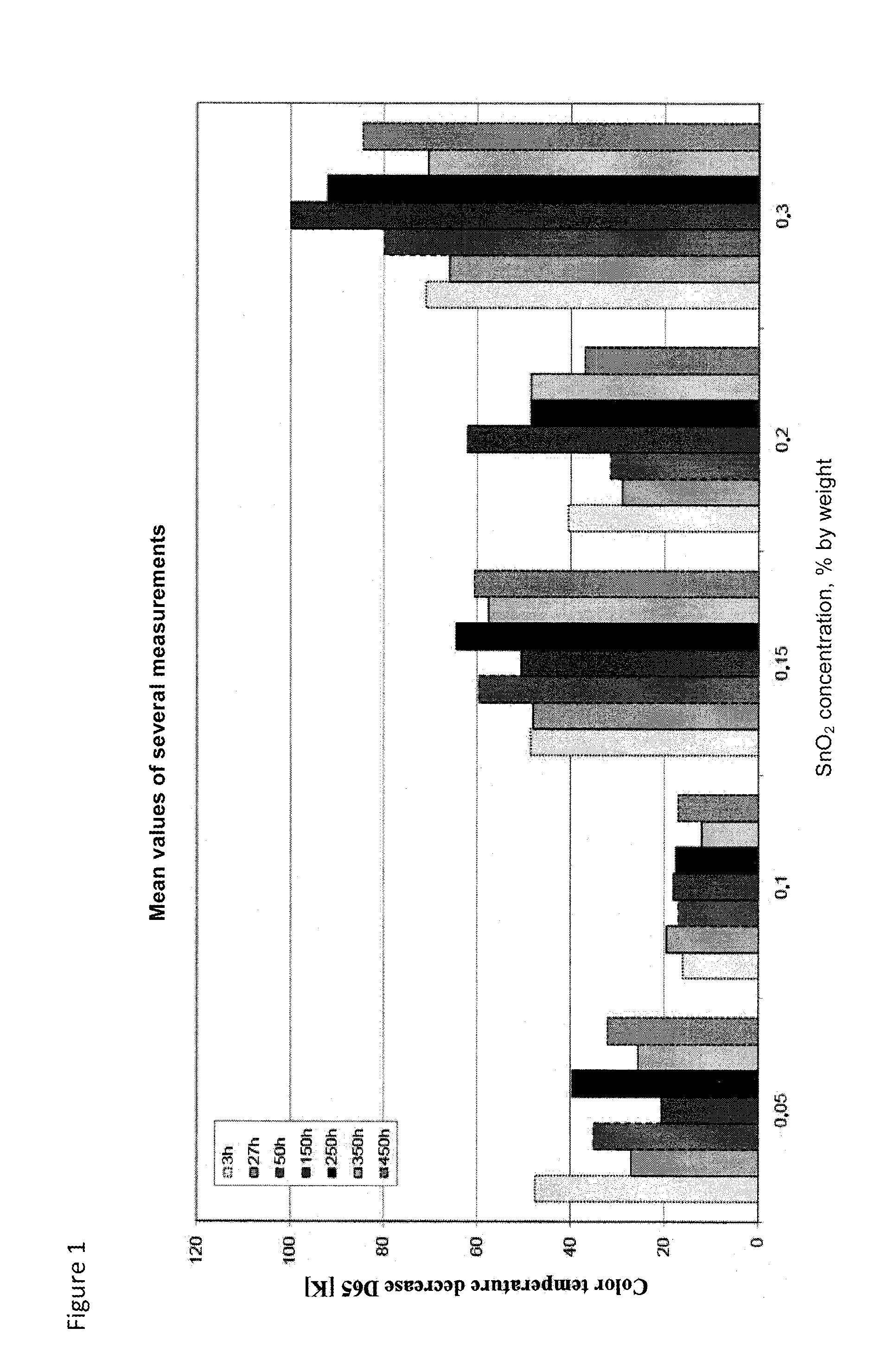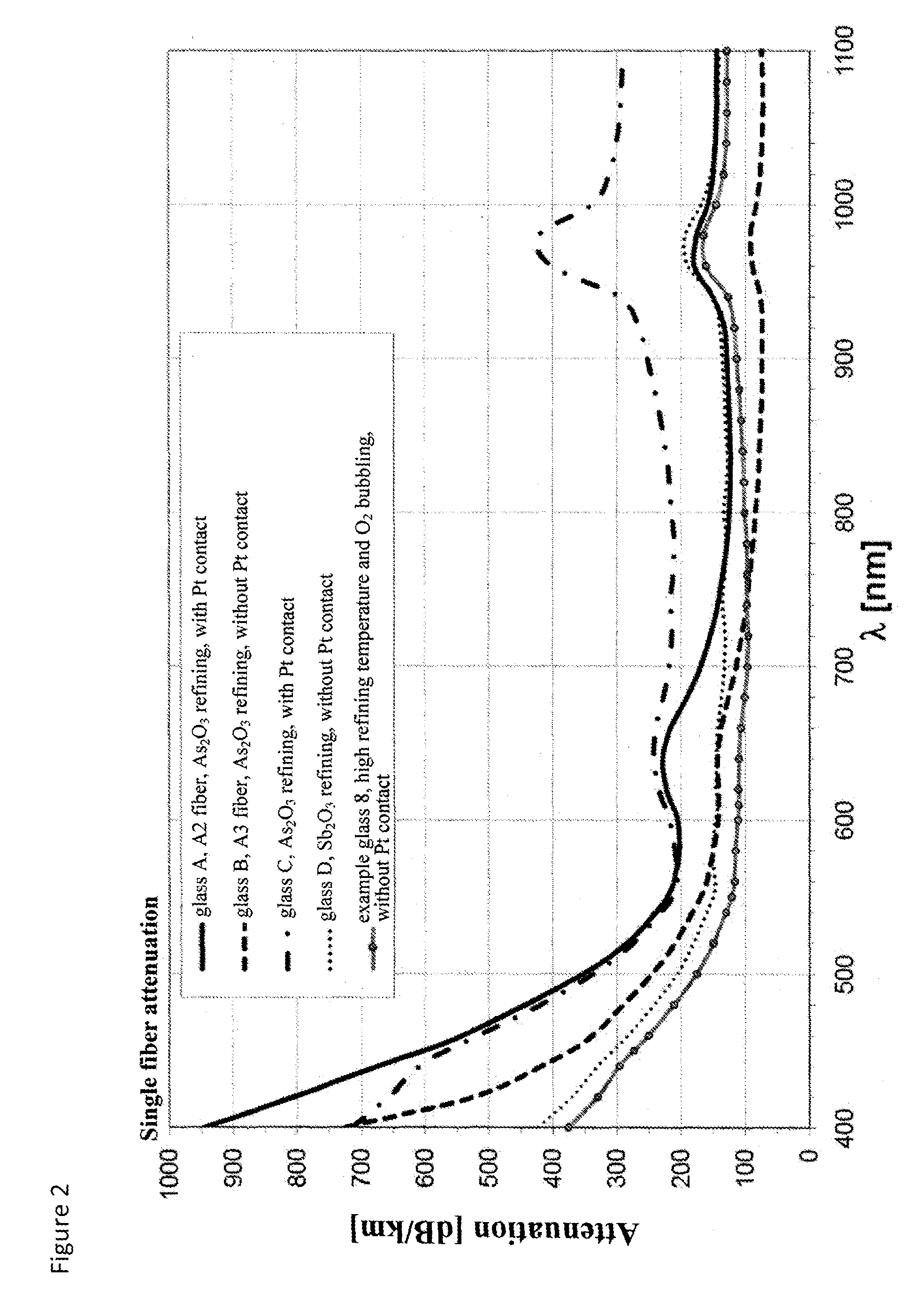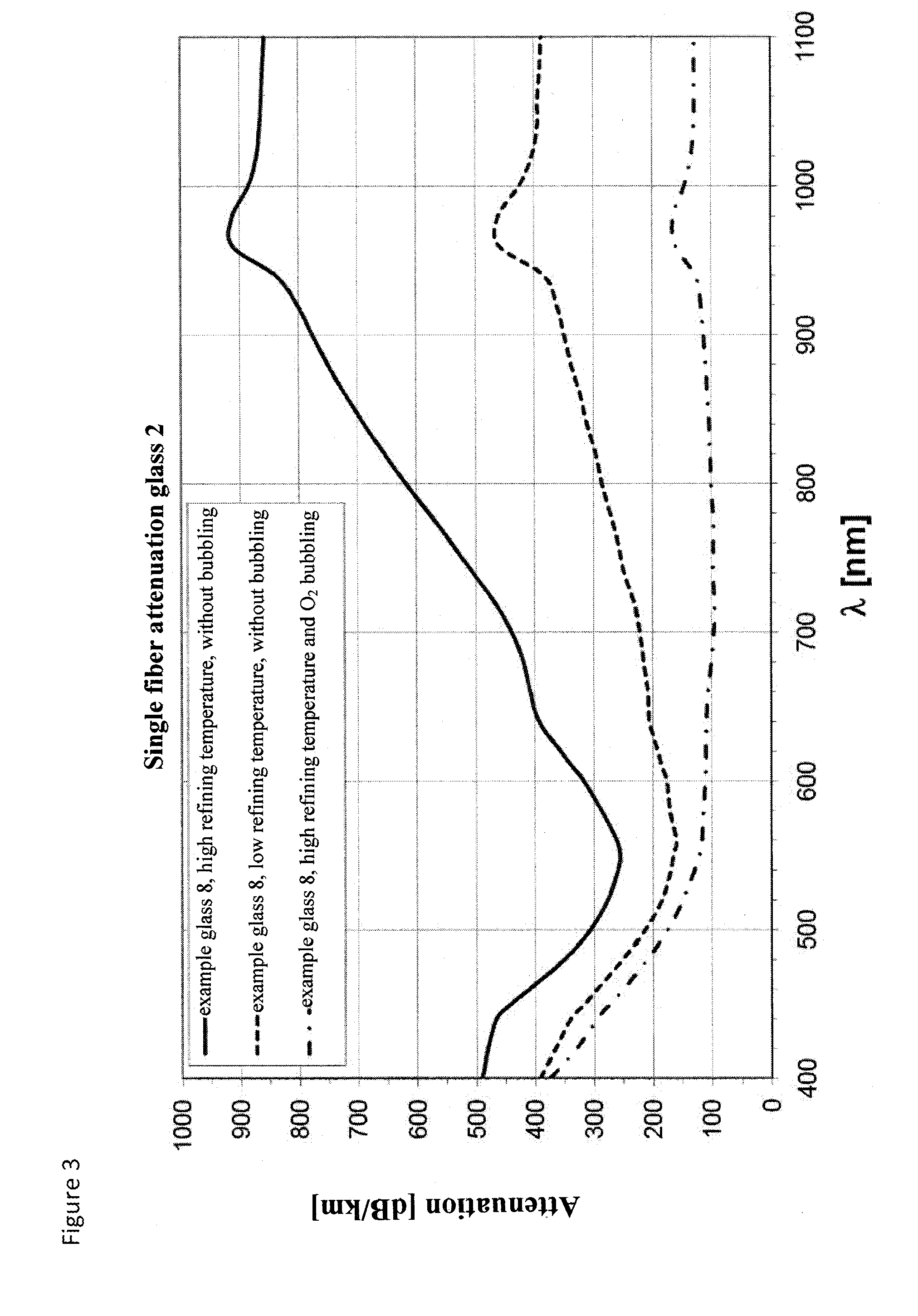The raw materials for melting of such core glasses are relatively expensive, due to their high purity.
This can result in high manufacturing costs of such fibers or therefrom manufactured optical fibers.
Furthermore, toxic components like, PbO, CdO, As2O3, BeO, HgO, Tl2O, ThO2 should not be utilized for reasons of
environmental protection.
This commonly results in yellowness of the emitted light.
This interferes with applications, in which a neutral
color reproduction is crucial, e.g. in medical
endoscopy, in photographic
documentation of images for the differentiation of e.g. healthy and malign tissue and others.
Furthermore, the melting aggregates are of importance, because they can also cause
contamination, and thereby negatively influence attenuation and other features.
The adjustment of these parameters is hindered by such an initialized more unstable melting process.
Furthermore, these refining agents are not desirable due to their toxic effects.
The glass described in this application has to be refined at low temperatures, because otherwise the content of
platinum in the glass becomes too high.
With the use of these refining agents an excellent solarization resistance cannot be achieved.
Tin refining is not a recommended option.
However, it uses high amounts of CaO and MgO.
Furthermore, TiO2 is used, which affects attenuation of the glasses especially in the UV-range.
Moreover, many components are used that increase the
refractive index, which, due to ever present contaminations, prevents good attenuation.
In addition, in prior art the omission of PbO as a glass component results in a strong decrease of the PbO mediated solarization resistance.
A small
impurity of iron cannot be prevented.
But this is very expensive and laborious.
When the amounts are too low, then a satisfactory refining procedure cannot be conducted.
The latter is caused by the introduction of undesired impurities, such as for example
iron oxide, by the SnO2 and in addition by the increased
redox potential with these impurities.
In particular in the case of the use in the IR range a high portion of Fe2+ is disadvantageous.
This is because those components that increase the
refractive index are not obtainable in the highest purity.
When the
viscosity is too high during the bubbling procedure, then the bubbles in the glass melt cannot or just poorly bubble up, and this results in undesired formation of foam.
In the case that the
viscosity is too low, also the
residence time of the bubbles in the melt is too low.
In addition, bubbles are formed which are too big and thus a bubble surface is formed which is too small, wherein this results in an exchange of
oxygen which is too low.
Since for an efficient exchange of gas between the melt and the bubbles a large interface is required, bubbles which are too big are not desired.
These ratios cannot be determined analytically in a satisfactory manner and only with great effort (0.
Amounts of this component which are too low result in unstable glasses.
High
processing temperatures result in disadvantages: The very hot melts stronger
attack the materials with which they are in contact.
In addition, higher amounts of impurities are introduced into the glass which again may result in undesirable influences on the transmission and thus the attenuation and the solarization.
Furthermore, portions of SiO2 which are too high result in a lowering of the numeric aperture (NA).
Contents of Al2O3, which are too high, result in a strong increase of the
melting point of the glasses and thus may result in an increased production effort.
But alkali oxides compromise the
chemical resistance of the glass, when they are used in amounts which are too high.
In addition, alkali oxides increase the coefficient of expansion which in the case of heat-forming may cause the formation of cracks in the glass.
When these processes become too strong or when
diffusion of ions takes place which contribute to the formation of crystalline phases through depletion or concentration in the core glass or cladding glass, these
diffusion processes become counter-productive.
When in the core glass no Li2O is contained at all, then in the case of Li2O containing cladding glasses
diffusion of Li2O from the cladding glass into the core glass takes place which may negatively influence the
optical quality of the core-cladding interface.
However, with this measure no clear advantages are achieved in many glasses and SrO does not increase the
refractive index in the same extent like BaO.
However for achieving a high refractive index and at the same time good chemical resistance and low tendency to
crystallization often these components are not enough and further auxiliary oxides must be used.
When this component is used in amounts which are too high, then the tendency to
crystallization strongly increases so that the glass cannot be used any longer for
all fiber types.
In addition, La2O3 is extremely aggressive with respect to SiO2 containing
refractory materials.
But at the moment the prize and the purity of HfO2 compared with ZrO2 are still not competitive.
Moreover, Bi2O3 is easily reduced to Bi0 at high temperatures, which results in a grey veil.
Preferably, the glass is free of As and Sb, since these components are toxicologically questionable and thus often are not accepted.
In addition, these two components cause solarization.
The self-absorption in the UV range results in undesired yellowness of the glasses.
In particular in the case of Nb2O5 it has to be considered that the purity available at the moment is not satisfactory and that also undesired interface effects with a part of the cladding glasses are induced which may result in an increase of the attenuation.
If the content of these components is too low, the preferred refractive index is usually not obtainable.
Therefore, till today bubbling after refining has been assumed to be counter-productive.
Portions of SiO2 in the core which are too high do not longer allow the adjustment of the relatively high refractive indexes being adjusted with La2O3.
However, it is not foreseeable with certainty if cladding glasses, even if the necessary physical features are existent, do harmonize with the core glasses in every case and result in good step-index fibers.
 Login to View More
Login to View More 


